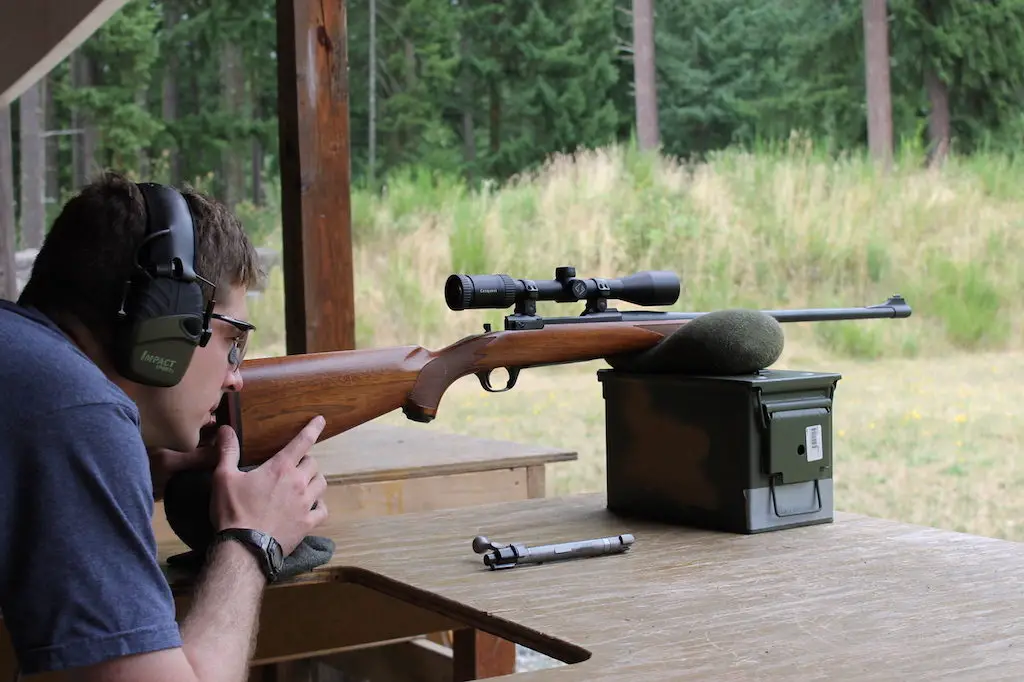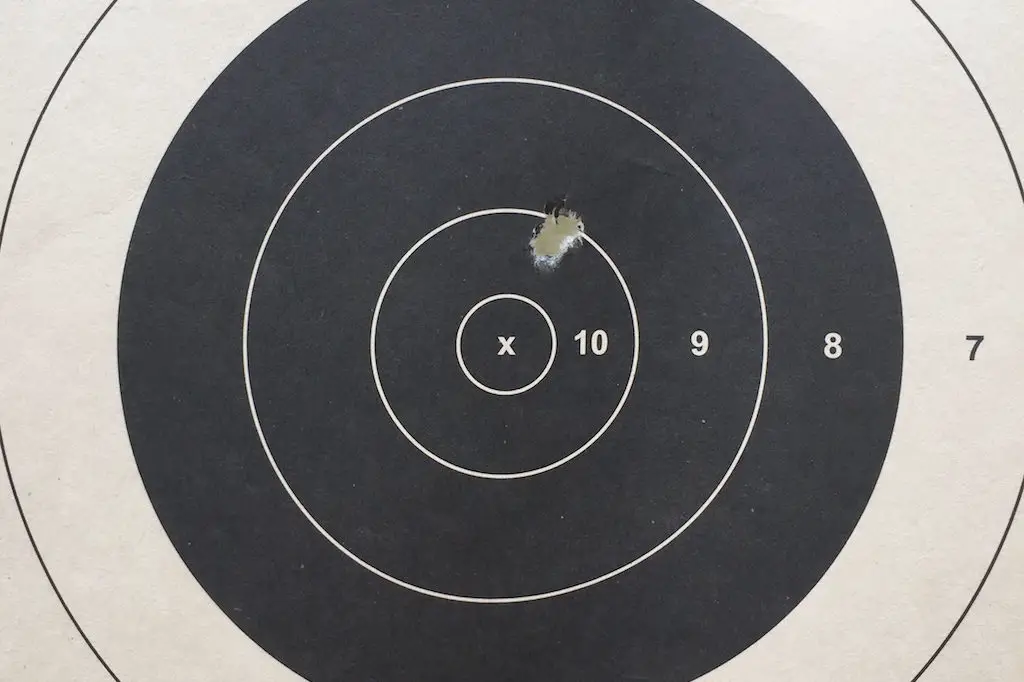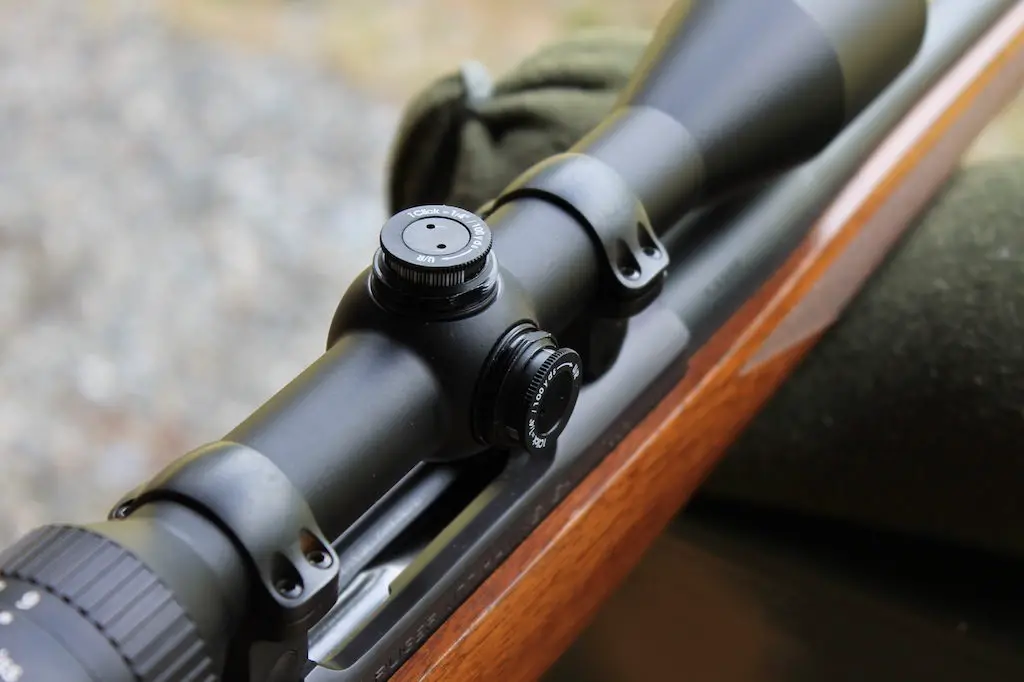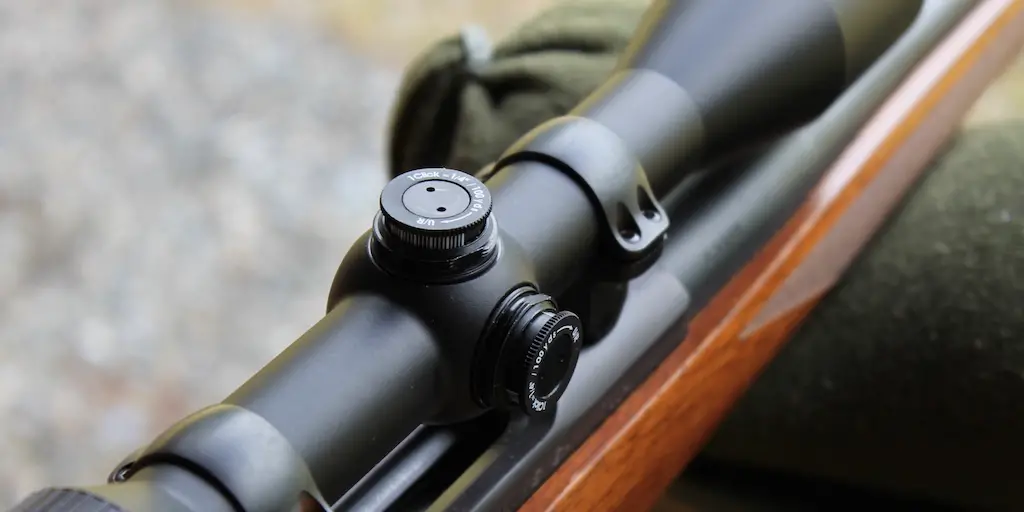Interested in finding out how to sight in a rifle with a scope? Keep reading for some step by step instructions.
Regardless of whether you’re hunting whitetail deer, cape buffalo, black bear, or some other big game animal, it’s crucial that you properly prepare your equipment for the hunt. Among other things, you should verify that your rifle is sighted in correctly so you can place your shots appropriately for a quick and ethical kill. Today, I hope to provide some assistance in this matter by providing a simple step-by-step guide on how sight in a rifle.
Specifically, since most hunters use telescopic sights on their rifles, this article describes how to sight in a rifle with a scope (get some great scope recommendations here) and the steps are the same regardless of whether you’re using an inexpensive optic or a high-end scope like a Leupold VX-5 HD.
How to Sight In A Rifle: Setting Up Your Scope
After you’ve mounted your new scope on your rifle, check one last time to make sure the scope is secure in the rings that the scope rings are tightly mounted to the base. There should be no wiggle whatsoever to the scope.
Next you’ll need to focus the reticle on your scope. You want the crosshairs to be instantly sharp and in focus when you look through the scope.
To do this, point the scope at a solid background (like the sky). Then look away from the scope for a few seconds at a distant object and let your eyes focus on it. Now, look back through your scope for an instant and then look away again.
Was the reticle perfectly in focus? Or was it a little blurry?
You’re looking for a snap judgement here because your eyes will start to adjust if you stare at the reticle for a few seconds.
If the reticle is blurry, twist the diopter adjustment on the scope. This is normally located at the end closest to the shooter. You can see it on my scope in the photo below just to the left of the word “Conquest.”
Continue to make adjustments until the reticle is clear and focused.

How to Sight In A Rifle: Boresighting
When you mount a new scope on a rifle, it’s best to bore sight it before actually shooting the rifle. First, ensure that the rifle is unloaded and that the barrel is unobstructed. Then, remove the bolt of the rifle and mount the rifle in a secure rest pointing downrange. Standing behind the rifle, look through the bore and center the target in the bore by carefully moving the rifle.
Your view when looking down the bore of the rifle should look something like the photo below. Then, without moving the rifle, adjust the scope to center the reticle on the same target. The turret on the top of the scope adjusts the elevation (up and down) of the reticle while the turret on the side adjusts the windage (left and right). It is not vitally important for the bore sight to be extremely precise.

It just needs to be close enough so that the rifle will hit somewhere on paper at 25 yards in the next step. You can also use a laser bore sight that fits in the chamber of the rifle to accomplish the same task. The end goal is still the same though: ensure the scope reticle is centered where the rifle is pointing. The laser just makes it a little easier to be precise than merely looking down the bore of the rifle.
BUY A GOOD LASER BORE SIGHT HERE
How to Sight In A Rifle: Getting On The Paper
After bore sighting the rifle, you’re ready to start shooting (be sure to put on ear protection first). It should go without saying, but I’ll say it anyway: when you sight in your rifle prior to going hunting, make sure you use the exact same type of ammunition that you’ll be using on the hunt. Some rifles are more picky than others, but it is virtually guaranteed that your shots will shoot to a different point of impact if you sight in your rifle with one type of ammunition then use a different brand or bullet weight on your hunt.
I like to shoot at 25 yards first, then fine tune my zero at longer ranges. I’ve learned that this saves time, ammunition, and frustration in the long run by avoiding taking shots at 50 or 100 yards that don’t even hit the target. The exact target doesn’t really matter at 25 yards as long as it has a distinct aiming point. Some people use bulls-eye targets with lots of success. I prefer to use a dedicated zero target with an easy to use grid format that helps easily determine my adjustments.
You can also buy a “shoot and see” or a “splatter burst” type target that makes it easier to instantly identify your bullet impacts without having to walk down range or use a spotting scope.
BUY SOME GOOD ZERO TARGETS HERE
When sighting in your rifle, it is very important to shoot from a stable position with lots of support. Use sandbags or a specially built rifle rest to do this. Whenever possible, avoid supporting the rifle with your muscles as this is less precise than using a stable object like a shooting bag.
BUY SOME QUALITY SHOOTING BAGS HERE
Once you’re set in a steady position, fire three shots at the center of your target at 25 yards. You may be able to see your bullets holes in the target through your scope. No matter where you see the bullet holes in the paper, do not change your point of aim.
Keep aiming at the bulls-eye for the entire group!
It’s ok if you don’t hit the bulls-eye at first. In fact, you almost certainly won’t.
After you fire your first group, check the target to see where you’re hitting. Measure from the center of your group to the bulls-eye and adjust your scope accordingly. Most rifle scopes have 1/4 MOA adjustments.

This means that 1 click will adjust the scope to move the bullet impact 1/4″ at 100 yards. However, this means that you need to make 4x times number of clicks (16 clicks=1″) to move the bullet impact the same distance at 25 yards. For example, the point of impact on the target below needs move 1/2″ left and 1″ down.
At 25 yards with a 1/4 MOA scope, that’s 8 clicks left and 16 clicks down.The turret on top of the scope moves the bullet impact up and down, while the turret on the side moves it left and right. As you can see in the photo below, most scopes have the measurement increments annotated on the turret along with the proper direction to turn it.

In the case of the scope on my rifle, turning the turret clockwise will move the impact of the bullet up or right, depending on which turret you are adjusting.For example, assume I shot a group at 25 yards that hit 1″ low and 4″ to the right. Since I need to move the bullet impact up and to the left, I’d turn the top turret 16 clicks clockwise and turn the side turret 64 clicks counterclockwise.
A trick I like to use is to go several clicks past the required number, then go back. For instance to adjust the scope 16 clicks clockwise, I’d go 20 clicks clockwise, then 4 clicks counterclockwise on the top turret. After that, gently tap the turret several times to lock in the adjustments. This is even more important when making very large adjustments or when using low quality scopes.
After making the required number of adjustments, shoot another group at the bulls-eye. If that group hits where you’re aiming, you’re ready to move the target out to 100 yards (or whatever range you want to zero your rifle for). If not, make the necessary adjustments to the scope and shoot until the rifle is dialed in at 25 yards.
Make sure you let your barrel cool adequately between groups though. This is more of an issue with some cartridges (like the .300 Win Mag) than others, but most rifles will shoot to a different point of impact with a hot barrel.
So, if your barrel is hot to the touch after shooting a group, just take a few extra minutes to let it cool down before shooting again. If possible, place the rifle standing upright in the shade with the bolt open for the fastest results.
How to Sight In A Rifle: Fine Tuning
Using the same techniques described earlier, shoot a group at 100 yards. Since you zeroed the rifle at 25 yards, it should be at least hitting the paper at 100 yards. Measure the distance from the center of your group to the bulls-eye and adjust the scope as necessary.
Remember: 4 clicks=1″ at 100 yards, not 16, like at 25 yards!
If you decide to sight in your rifle with a 200 yard zero, then 2 clicks=1″ with a 1/4 MOA scope.
When zeroing at 100 yards, your windage should be dead on. However, there is some debate as to where your shots should be hitting elevation wise. If you’ll be hunting at a relatively short range and/or using a cartridge like the .30-30 Winchester or the .45-70 Govt that have a more “rainbow” like trajectory, then it’s probably best to adjust your scope so that the bullets are hitting the bulls-eye at 100 yards.
However, sighting in your rifle so it hits slightly high at 100 yards has advantages as well. Each rifle and cartridge is different and an ideal 100 yard zero varies. Using my rifle in the photos (a Ruger M77 Hawkeye in 9.3x62mm Mauser) as an example, I sight it in so my shots hit about 2″ high at 100 yards. With this set up, the bullet will hit ~1″ high at 50 yards, ~1″ high at 150 yards, dead on at 165 yards, and ~3″ low at 200 yards. This means that without having to adjust my scope or my point of aim, I can take a shot on a deer out to 200 yards and still hit the vitals.
It may be better to sight in your rifle with a 200 yard zero instead if you’re using a flat shooting cartridge like the 6.5 PRC, 270 WSM, 7mm PRC, 7mm Remington Magnum, or .300 Winchester Magnum and plan on hunting at longer ranges.
This is easier if you’re at a range that’s long enough where you can simply shoot a target at 200 yards and adjust your scope appropriately. If your range only goes out to 100 yards, then you’ll need to see how high your shots should be hitting at 100 yards for a 200 yard zero. Most boxes of ammunition have that information on them or you can use a ballistic calculator. Then, sight in your rifle so that it hits the correct distance above the bulls-eye at 100 yards.
After you’ve made your final adjustment, fire one last group to confirm it. If the group hits where you want it to, you’re done. Though it’s always a good idea to check your zero prior to hunting season, a good scope will hold a zero for a long time as long as you don’t drop or damage it.
I hope you found my description of how to sight in a rifle with a scope useful and interesting. Are there any other tips or tricks out there that I might have forgot to mention?
Enjoy this article on how to sight in a rifle with a scope? Please share it with your friends on Facebook and Twitter.
Make sure you follow The Big Game Hunting Blog on Facebook, Instagram, Twitter, and YouTube.
NEXT: HERE’S HOW YOU SHOULD BE CLEANING YOUR BOLT ACTION RIFLE
NEXT: BEST RIFLE SLINGS
John McAdams is a proficient blogger, experienced shooter, and long time hunter who has pursued big game in 8 different countries on 3 separate continents. John graduated from the United States Military Academy at West Point and is a veteran of combat tours with the US Army in Iraq & Afghanistan. In addition to founding and writing for The Big Game Hunting Blog, John has written for outdoor publications like Bear Hunting Magazine, The Texas State Rifle Association newsletter, Texas Wildlife Magazine, & Wide Open Spaces. Learn more about John here, read some of John’s most popular articles, and be sure to subscribe to his show: the Big Game Hunting Podcast.



Hi John, GREAT article on sighting in a rifle and you made excellent use of the ABC’s of writing (Accurate, Brief, and Concise). You made the information easy to understand, did not burden the reader with excessive calculations or mathematics, and provided great step by step instructions. Thanks much!
Thanks Dan! Glad you found it useful!
I have a 4 – 9 x 32 scope on a remington woodmaster 30.06, I have it zeroed at 100 yards on the 4, my question is, if I increase magnification to 9, do I have to adjust where I put the cross hairs or can I still hold dead on at 100 yards or do I need to adjust up or down based on the magnification? Thank you
If you’re using a second focal plane scope, then you do not need to adjust where you’re aiming if you change magnification. The vast majority of hunters use second focal plane scopes where the reticle stays the same size at all magnifications. If point of impact changes significantly as you adjust magnification with one of those scopes, then there’s something wrong with your scope.
John